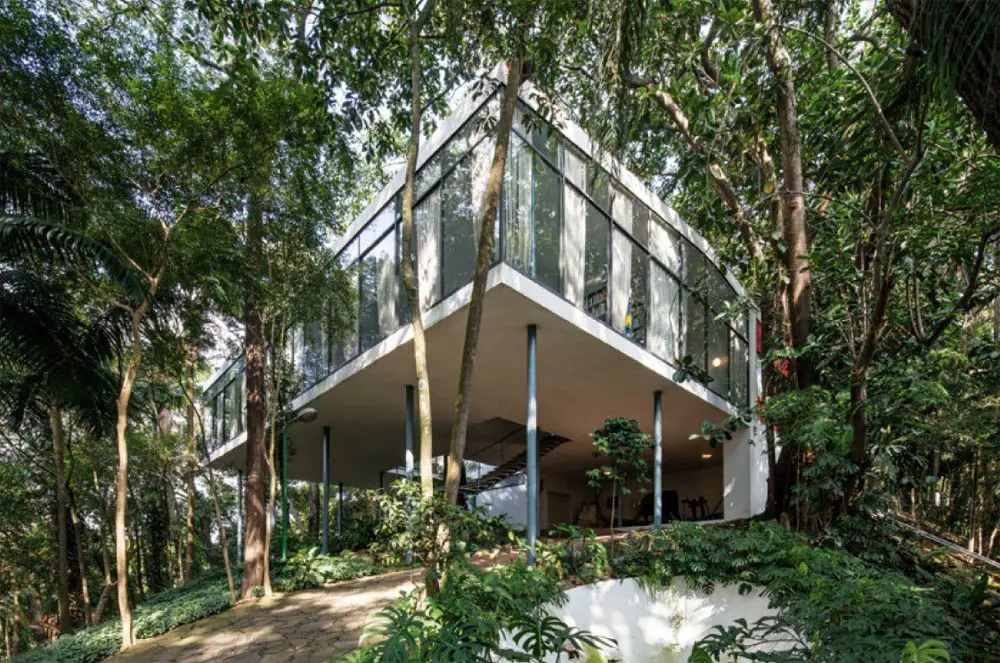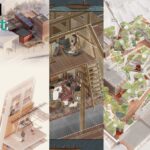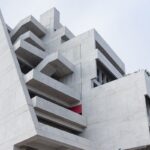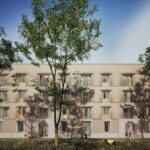Keeping It Modern Architectural Conservation Grants 2016, Post-war Architecture, Modernist Buildings Photos
Keeping It Modern 2016 Architectural Conservation Grants
Getty Foundation Modernist Architecture Funding – 20th Century Built Environment Renewal
29 Jul 2016
Keeping It Modern Architectural Conservation Grants 2016
Getty Foundation Keeping It Modern 2016 Architectural Conservation Grants
Keeping It Modern 2016 Architectural Conservation Grants
Association de Gestion du Site Cap Moderne, Villa E-1027
Recommended amount: $200,000
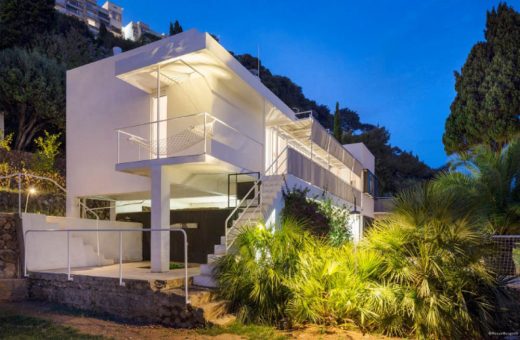
Villa E-1027, Cap Moderne, photograph Manuel Bougot www.manuelbougot.com. 2016
On the rocky hillside shore of southern France’s Côte d’Azur sits the Villa E-1072 built by Eileen Gray (1878–1976), one of the most innovative furniture designers of the modernist era. Constructed between 1926–1929 as a retreat and vacation home for Gray and architectural critic Jean Badovici, the Villa is a model of Gray’s uniquely balanced approach to modernism that attends to the inhabitants’ practical and spiritual needs.
In addition to paying close attention to the furniture and interior design of the home, Gray also carefully planned the surrounding landscape and gardens. Not long after its completion, her vision was compromised when a series of seven murals were painted inside the villa by famed architect and neighbor Le Corbusier in 1938 and 1939 at the request of Badovici but without Gray’s consent following the couple’s separation. Although not part of her original design, the murals remain today as part of the building’s history and fabric.
Following decades of environmental stress and multiple private owners since 1960, the building had suffered years of neglect. A recent restoration project completed in 2010 stabilized the site, and now the Villa is under the care of the Association Cap Moderne, a non-profit organization that is committed to the long-term maintenance of this Monument Historique.
Their analysis has revealed the need for a comprehensive conservation plan, as well as additional scientific research to mitigate the key environmental challenges of the site: exposure to corrosive sea air and water runoff on its steep slope. The Getty grant will allow a preeminent conservation architect and an experienced landscape architect to develop the plan and guide the research.
The project will include analysis of the reinforced concrete, a scientific study of the original color scheme, climate control research, a furniture study, and a special scientific analysis of the Le Corbusier murals to inform their future restoration. The resulting conservation plan will not only ensure the future care of Villa E-1027 but will also inform an effort to provide public access to the overall site, which also includes three adjacent buildings by Le Corbusier.
Highland Green Foundation Inc., First Presbyterian Church
Recommended amount: $130,000
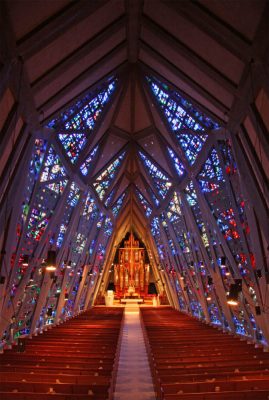
First Presbyterian Church, interior of Sanctuary. Photo by Robert Gregsoni
Completed in 1958, Wallace Harrison’s (1895–1981) fish-shaped First Presbyterian Church in Stamford, Connecticut, marries innovative modernist design with the colorful stained-glass and soaring interior space of traditional religious architecture. The church was constructed with prefabricated, triangular panels of precast concrete that are activated by sparkling sanctuary windows containing over twenty thousand pieces of amber, emerald, ruby, amethyst and sapphire glass.
Harrison’s use of dalle de verre windows—a glass art technique that places colored glass into a matrix of concrete—set a new precedent in achieving elegance with cost-effective pre-fabricated materials. The architect’s design went on to garner international attention—the church was featured in the Museum of Modern Art’s important 1959 exhibition Architecture and Imagery – Four New Buildings—and inspire others to incorporate dalle de verre windows into the non-load bearing walls of hundreds of ecclesiastical and monumental civic buildings that followed.
Through the years the church’s congregation has responsibly managed problems of water infiltration, aging infrastructure, and deterioration of the stained glass as they developed, keeping the complex in a structurally sound condition. However, the Highland Green Foundation, Inc., which is responsible for the site’s maintenance, recognizes that the building’s long-term care depends on its ability to plan, fundraise, and implement a long-term conservation plan for the church and the adjacent tower and parish building.
A Getty grant will enable a team of experts to survey, document, and study the site, drawing on the input of engineering consultants and material scientists. The results will form a conservation management plan that will guide future interventions and maintenance at this site and can also be applied to other modern buildings with dalle de verre glass.
Instituto Lina Bo e P.M. Bardi, Casa de Vidro
Recommended amount: $195,000
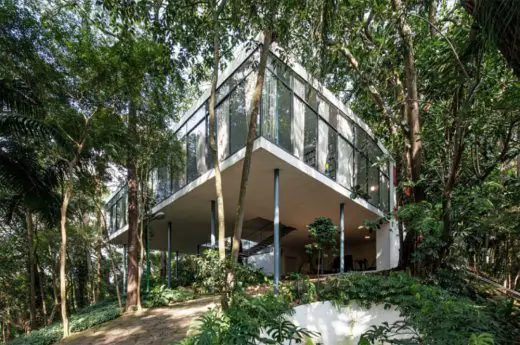
Casa de Vidro © Leonardo Finotti
Brazil is renowned for its mid-century architecture, and Lina Bo Bardi (1914–1992) stands out as a leading practitioner of the modern movement, designing many of the country’s most iconic buildings. A precursor to her larger civic projects, the Casa de Vidro, or Glass House, in São Paulo was designed and built between 1950 and 1952 at a critical point in the architect’s career. Created as a personal residence for Bo Bardi and her husband after emigrating from Italy in 1946, the house was her first completed work as an architect and as a new Brazilian citizen.
Casa de Vidro demonstrates Bo Bardi’s resourceful use of low-cost fabrication techniques and industrially produced materials, as well as her adaptation of European modernism to the natural settings and craft traditions of Brazil. Rooted to the earth with delicate posts, the main volume of the house floats graciously above the ground, maintaining a seamless relationship with the surrounding landscape through large panes of transparent, sliding glass.
Since 1995 the Casa de Vidro has been under the stewardship of the Instituto Lina Bo e P.M. Bardi, which was established by the architect and her husband to display and promote Brazilian culture and arts. While sound maintenance practices and several large renovation projects have kept the site in good condition, the Instituto recognizes the need for a preventive, scheduled maintenance plan based on specialized technical surveys to avoid an uncertain future of emergency interventions and ad hoc spot repairs.
A Getty grant will allow an international team of conservation architects, landscape conservation specialists, cultural heritage experts, and civil and structural engineers to develop a conservation management plan for the property. The project will also include a 3D topographic survey of the site that allows engineers to identify potentially harmful structural deformations at the smallest scale, not perceivable to the naked eye. The results will be shared with researchers and custodians of other glass houses, such as those by Philip Johnson, Mies Van Der Rohe and Charles Eames.
Comisión del Patrimonio Cultural de la Nación, Cristo Obrero Church
Recommended amount: $150,000
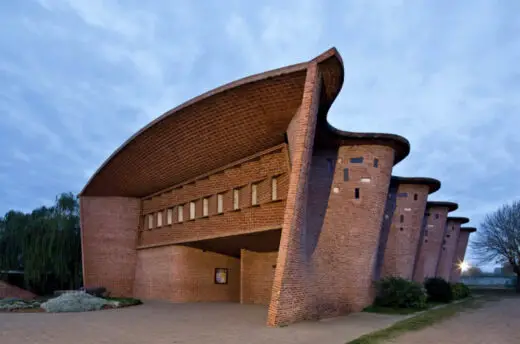
Cristo Obrero Church. © Leonardo Finotti
Situated on the outskirts of Atlántida in Uruguay, the Cristo Obrero y Nuestra Señora de Lourdes church is the first independent commission of celebrated Uruguayan architect and engineer Eladio Dieste (1917–2000) whose prolific portfolio includes over 200 structures in Latin America and Spain. Dieste forged his reputation by ignoring the traditional use of brick in favor of an experimental approach that treats the material as if it were fully pliable.
Over the years, he developed and refined a number of groundbreaking features that include free-standing vaults, undulating surfaces, and folded planes, all of which were based on his rigorous understanding of geometry, engineering, and the integration of steel and brick.
The Cristo Obrero church was fabricated with two layers of red bricks surrounding a pre-tensioned iron armature, demonstrating both his preference for locally available materials and his unparalleled engineering acumen. Carefully placed windows and brick apertures contain colored glass that diffuse the interior lighting. The bell tower is equally ingenious, with its perforated walls and an open circular staircase that ascends without a single support column or handrail.
While the church has been maintained by the local community, it has begun to show signs of aging, including leaks that require immediate attention. Compounding the need for repair is the fact that Dieste’s engineering is not always fully understood, making it difficult to develop conservation plans without in-depth technical analysis.
To address the problem, a team of national and international experts will use Getty support to embark on a rigorous study of the church and bell tower that will result in a comprehensive engineering study and a conservation management plan. The technical studies will shed light on the nature of Dieste’s structural innovations, which will inform the conservation and care of his many buildings across Uruguay and beyond.
ArchiAfrika Accra, Children’s Library
Recommended amount: $140,000
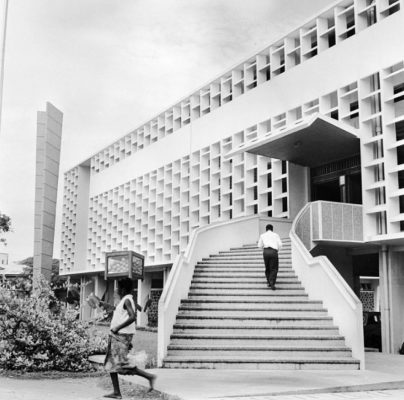
Facade of the Children’s Library in Accra. Photo by Evans/Three Lions/Getty Images
Soon after its independence in 1957, post-colonial Ghana began a building campaign that affirmed the country’s optimism and established Accra as a center of West African Modernism. An emblem of this movement is the Children’s Library in Accra, designed by the architectural firm of Nickson and Borys in 1966.
A deceptively simple façade forms a bris-de-soleil that shields a series of semi open-air spaces from direct sunlight to facilitate natural airflow and cooling. The climate-sensitive design and materials ensured effective functioning of the building without the added need for indoor temperature control, making the library a prime example of “Tropical Modernism.”
Owned by the Accra Metropolitan Assembly and maintained by the Ghana Library Board, the Library is recognized as a National Heritage building by the Museum and Monuments Board of Ghana. While the building has been well-maintained over the years, it has never been upgraded nor has it been studied in any detail.
In order to ensure that the building is preserved to the highest standards moving forward, a dedicated group of local experts has assembled an international team of specialists that will use Getty support to collaboratively research the library complex and develop a conservation plan. The project team will incorporate training for university students from Ghana and the U.K., and the research results will be shared with international and local audiences through an exhibition about the library’s history.
The Writers’ Union of Armenia, Sevan Writers’ Resort
Amount recommended: $130,000
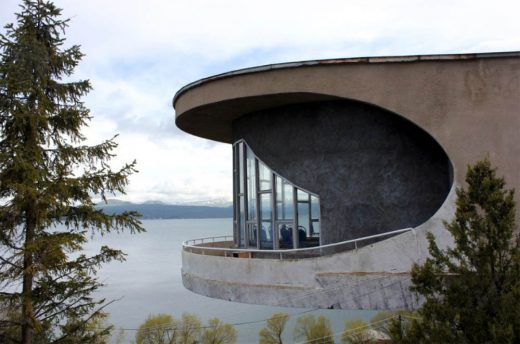
Sevan Writers’ Resort. Photo by Jens Mallings; Courtesy of Jens Malling archive
Between 1932 and 1965 during Soviet rule, a picturesque retreat for the Writers’ Union of Armenia was built on the sprawling shore of Lake Sevan outside the nearby capital of Yerevan. The two buildings that form the Sevan Writers’ Resort—the guest house (1932-1935) and the lounge (1963-1965)—were designed with strikingly divergent aesthetics, but share the same architect.
The markedly different stylistic choices are the result of Armenia’s close, but often fraught relationship with the Soviet Union. The guest house, designed by Gevorg Kochar (1901–1973) and Mikael Mazmanyan (1899–1971), is a model of early Soviet avant-garde ideals, utilizing abstract forms to represent social utopianism and creating a functional, progressive and egalitarian space that exemplified the ideals of the revolution.
Two years after the completion of the guest house, the architects fell victim to the Stalinist regime; they were arrested and exiled to Siberia for 15 years. Rehabilitated after Stalin’s death, Kochar was commissioned to add the lounge and reconstruct the guest house in 1963. Emulating the international style, the new building complemented the guest house and harmonized the ensemble with the natural landscape, incorporating the view of medieval monastic churches located at the end of the peninsula. To this day, the site continues to be used by Armenian authors for rest and contemplation.
Armenia was established as an independent state in 1991 after the fall of the Soviet Union. Today, many of the great architectural icons of the Soviet period are under threat or have already been demolished as the country has moved away from its Soviet past. A Getty grant will support the methodical and scientific analysis of the Sevan resort, and the resulting conservation management plan will set a precedent for valuing modernist heritage not only in Armenia, but also in other post-Soviet and post-socialist countries. Although the region’s history is complicated and often painful, buildings like the Sevan resort complex stand as monuments to this past.
Liverpool Roman Catholic Archdiocesan Trust, Liverpool Metropolitan Cathedral
Recommended amount: £138,000
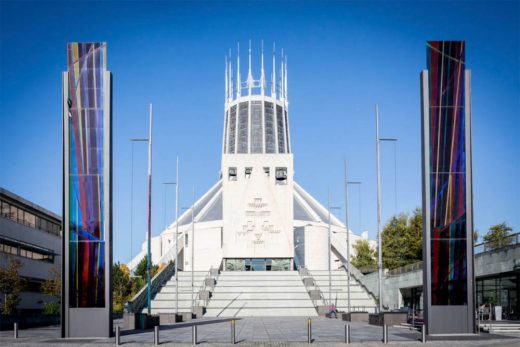
Liverpool Metropolitan Cathedral, exterior. © Purcell Architects
Completed in 1967, Liverpool Metropolitan Cathedral is the culmination of a century-long effort to construct a Catholic cathedral for the city. Designed by Sir Frederick Gibberd (1908–1984), who is renowned for his architecture, town planning, and landscape design, and constructed over the crypt of an unfinished cathedral by Sir Edwin Lutyens, the sanctuary soars above the city’s skyline, a crown-shaped emblem of faith reinterpreted in the language and materials of modernism.
Gibberd worked closely with a team of artists to achieve his vision, a collaboration that resulted in the cathedral’s distinctive lantern tower that rises from the building’s conical core to culminate in a crown of pinnacles. The lantern’s dalle de verre stained glass includes an impressive palette of translucent colors that form a stark contrast with the surrounding raw concrete.
Defects in the construction became apparent early on, including surface and internal leaking and the failure of mosaic cladding to the concrete buttresses. Repairs to remedy these defects, begun in the 1990s, resulted in alterations to the building, including cladding over the mosaics and replacement of the roof.
Today the Archdiocese of Liverpool remains a committed custodian of the cathedral, most recently commissioning research into the ongoing failure of the dalle de verre in the building’s Lantern. A Getty grant will support the completion of this analysis, including environmental monitoring and 3D models to document the as-built structure and to allow environmental simulations of the building’s performance.
The research will also be used to develop and test a conservation repair methodology for the dalle de verre glazed Lantern, which is currently the cause of significant water ingress. The study of the dalle de verre, along with that for First Presbyterian Church, will also advance the understanding of the material’s deterioration and approaches to its repair, for which the field currently lacks consensus.
Nirmala Bakubhai Foundation, Gautam Sarabhai Workshop Building
Recommended amount: $90,000
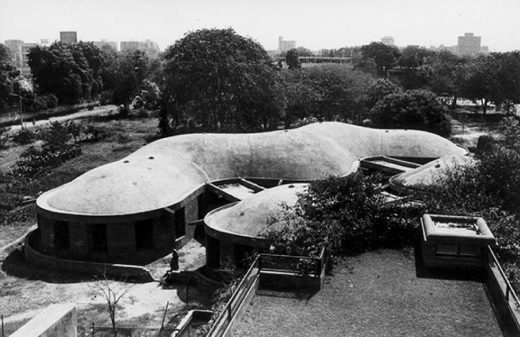
Roofscape / Archival image. Photograph (c) Sarabhai Foundation
Designed by Gautam Sarabhai (1917–1995) and constructed as a vocational training center affiliated with the B.M. Institute for Mental Health in Ahmedabad, the workshop building (1976–1977) is a significant example of India’s modern architectural heritage. Resulting from local applications of modern engineering and design, the building was inspired by the early work of Frei Otto and embodies Sarabhai’s belief that elegant forms emerge from pushing engineering to its limits.
The resulting structure is made of a light-weight steel grid frame that is covered by a thin-shell Ferro cement roof, achieving a large column-free space with an unsupported span of 134 feet. Two smaller adjoining administrative additions were constructed using bamboo instead of steel, which was unprecedented in the fabrication of thin-shelled concrete structures.
Sarabhai purposely sought to create a structure that could be built without expensive formwork or specialist contractors, but that would nonetheless advance modernist ideals in its concept and construction. Working with a highly skilled local mason, he succeeded brilliantly. Due to its lightweight structure and inherent ability to flex, the building withstood the 7.7 earthquake that devastated the region in 2001, without sustaining significant damage.
To ensure that the structure will continue to perform as it has over the past forty years, the owners are dedicated to researching the building’s performance in order to prepare a comprehensive conservation plan. The B.M. Institute has assembled an international team of experts for the project that possess as much cutting-edge knowledge as the original designers and builders did.
The project team includes Sarabhai’s grandson, a trained architect, and leading conservation experts from India and Europe, who will incorporate teaching exchanges and training for the studio’s maintenance staff. The project will also develop a Building Information Model, a software that is increasingly used by the field for asset management, which will be critical in understanding and monitoring the condition of this unique building.
Kosovo’s Architecture Foundation, National Library of Kosovo
Recommended amount: $89,000
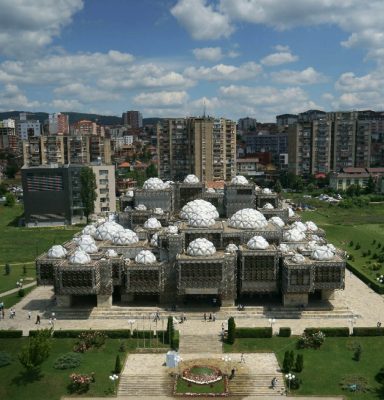
National Library of Kosovo, view from west. Emanuel Gjokaj/Kosovo Architecture Foundation
Few modern buildings connect the past and present as flawlessly and span multiple cultures as expressively as Kosovo’s National Library in Prishtina. Reflecting on the region’s diverse heritage and distinct cultural spirit, Croatian architect Andrija Mutnjakovic (b. 1929) sought to create an authentic national architectural expression when he designed the building in 1971. Constructed with in-situ cast concrete, marble floors, and white plastered walls, and topped with 99 translucent acrylic domes, the library is reminiscent of buildings from Byzantium and the Ottoman Empire.
Despite its unified historic forms, the structure is unmistakably modern. Mutnjakovic used new materials to evoke ancient architectural tropes, most notably the exterior aluminum lattice-wrapping, which can be interpreted either as a fishnet or a veil pointing to the area’s two predominant religions. Although reception of the design was mixed when the library opened in 1982, the building is now regarded as an extraordinary example of late Yugoslav modernism and a beloved space in the community.
While the building’s interiors suffered damage during the Kosovo War (1998-1999), its exterior escaped the conflict relatively unharmed. However, over the past several years, the building has begun to show signs of aging, most evidently though water ingress that required ad hoc repairs. Moving forward, a team of conservation specialists will address the lack of knowledge about the building, studying and assessing its performance with the support of a Getty grant.
They will analyze every aspect of the building, including consulting with the architect on historic documents and his own personal knowledge of the design. Their research will create a comprehensive record of the building’s past and current conditions and result in the preparation of a nomination for the protection of the library at the national level.
When completed, the project will serve as a model for modern building documentation in the region and will be shared with the public through an exhibition at the library. The project will also raise awareness for preserving 20th century architecture through a series of workshops for students and young professionals in the field.
Modern Architecture Funding – Getty Foundation Keeping it Modern – 29 Jul 2016
Location: 1200 Getty Center Drive, Los Angeles, California 90049-1685, USA
Modern Architecture – Major Modernist Buildings
Post-war Architecture
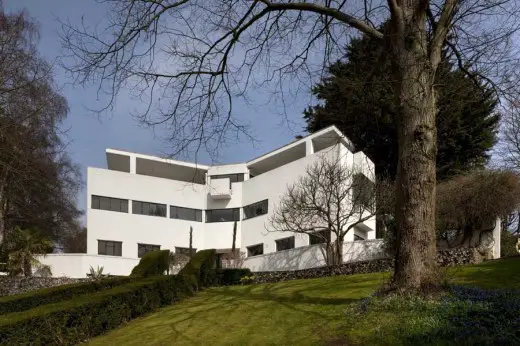
photo : Morley von Sternberg
Post-war Architecture
Most of these Modern buildings exude purity – simple forms, floating planes / cantilevers, white facades, strip windows – typical of Modernist Architecture.
These Modern buildings feature in standard Histories of Architecture Books, alphabetical:
Barcelona Pavilion, Spain
Design: Mies van der Rohe Architect
Barcelona Pavilion – probably the most famous Modern building in the world
Farnsworth House, Illinois, USA
Design: Mies van der Rohe Architect
Farnsworth House
Florida Southern Colleges – Child of the Sun, Florida, USA
Design: Frank Lloyd Wright
Child of the Sun Buildings
High & Over, Amersham, England
Design: Connell and Thomson / Architect: Amyas Connell
Modern English house – one of the first Modern houses in England
Highpoint I, Highgate, London, UK
Design: Berthold Lubetkin Architect
Modernist Housing : Highpoint Buildings
Hilversum Town Hall, The Netherlands
Design: Willem Marinus Dudok
Hilversum Town Hall Building
860-880 Lake Shore Drive, Chicago, USA
Design: Mies van der Rohe Architect
Lake Shore Drive Towers
Lawn Road Flats, London, UK
Design: Wells Coates
Isokon : Modern British building – classic white Modernist purity
Martin House Complex, Buffalo, USA
Design: Frank Lloyd Wright Architect
Modern Building in Buffalo
This is an interesting residential complex designed by one of the most celebrated architects of the 20th Century, Frank Lloyd Wright. It is the largest of his Prairie houses in the Eastern United States.
Miller House, Indiana, USA
Design: Eero Saarinen architect
Miller House
Sanatorium Zonnestraal, Hilversum, The Netherlands
Design: Jan Duiker with Bernard Bijvoet and Jan Gerko Wiebenga
Sanatorium Zonnestraal
This famous Modernist building appears in most histories of 20th Century Architecture and the Modern Movement.
Solomon R. Guggenheim Museum, New York, USA
Design: Frank Lloyd Wright
Guggenheim Museum New York – organic Modernist architecture
Tugendhat Villa, Brno, Czech Republic
Design: Mies van der Rohe Architect
Modern Architecture : Tugendhat Villa Brno
Unité d’Habitation building, Berlin, Germany
Design: Le Corbusier Architect
Modern Berlin Housing – Modernist design emanating from France
Villa Savoie, Poissy, France
Design: Le Corbusier Architect
Villa Savoie by Le Corbusier – famous Modernist architecture
Post-war Buildings
Le Corbusier Show : The Interior of the Cabanon
Modern Architecture Exhibition : RIBA, London
American Le Corbusier building: UN Building New York
Modern Architecture House : Frank Lloyd Wright house
Comments / photos for the Keeping It Modern 2016 Architectural Conservation Grants page welcome

